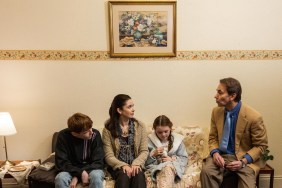Kathy Baker as Camille
Amy Brenneman as Lorna
Elpidia Carrillo as Sandra
Glenn Close as Maggie
Stephen Dillane as Martin
Dakota Fanning as Maria
William Fichtner as Andrew
Lisa Gay Hamilton as Holly
Holly Hunter as Sonia
Jason Isaacs as Damian
Joe Mantegna as Richard
Ian McShane as Larry
Molly Parker as Lisa
Mary Kay Place as Alma
Sydney Tamiaa Poitier as Vanessa
Aidan Quinn as Henry
Miguel Sandoval as Ron
Amanda Seyfried as Samantha
Sissy Spacek as Ruth
Robin Wright Penn as Diana
Summary:
A challenging dialogue-driven film showcasing powerful and emotional performances from a highly talented cast, but some of the “lives” work better than others.
Story:
Nine segments, all shot in one take, showing real people facing real problems: Sandra (Elpida Carrillo) is a female convict hoping to see her daughter. Diana (Robin Wright Penn) meets an ex-lover at the supermarket. Sonia (Holly Hunter) gets into a fight with her boyfriend during a dinner party. Samantha (Amanda Seyfreid) is caught between her fighting parents. Lorna (Amy Brenneman) faces her ex-husband at the funeral for his second wife. Ruth (Sissy Spacek) goes to a motel to have an affair. Camille (Kathy Baker) is in the hospital in a deteriorating condition. Maggie (Glenn Close) walks through a cemetery with her daughter Maria (Dakota Fanning).
Analysis:
You have to give filmmaker Rodrigo Garcia (“Things You Can Tell Just By Looking at Her”) high praise for putting together a project as ambitious as this one. Essentially, he has assembled a series of nine dialogue-driven vignettes, each featuring very different women in a different setting, all of them performed and shot in one continuous take. It’s as much a testament to Rodrigo as it is to his actors that something like this works as well as it does.
As an anthology film, this might at first be taken in the vein of Jim Jarmusch’s Coffee and Cigarettes, but there’s far more depth to the stories being told here, and the performances are stronger, making the women and their situations seem real. Despite the brevity of the segments, it’s hard not to get caught up in the lives of these women thanks to these performances.
Garcia’s camera acts as a fly-on-the-wall looking into the lives of these people, and though the impressive camerawork makes sense based on Garcia’s background as a cinematographer, he never allows the camerawork to overpower the performances. Like nine short stage plays, the initial strength of the scenes lie in the writing, and comparisons to Richard Linklater’s indie work, particularly Before Sunset, would certainly be valid.
The Linklater comparisons are most evident in the second segment, in which Robin Wright Penn plays a pregnant woman who encounters an old flame in a supermarket. That paramour is played by Jason Isaacs, who proves that he can do a lot more than play the bad guy. It’s a great scene that beautifully portrays the awkwardness of meeting someone from your past after you’ve moved on with your life, a sensual scene that shows off both actors’ amazing ability to convey subdued emotions.
Though I’m unfamiliar with Lisa Gay Hamilton, she knocks one out of the park as a trouble woman confronting her abusive father, and Kathy Baker is also terrific as a temperamental woman about to undergo surgery for breast cancer and taking it out on her loving husband, played by Anthony LaPaglia. In the most enigmatic and complex sequence, Amy Brenneman goes to the funeral of her deaf ex-husband’s wife, only to rekindle old feelings for him. It features an emotive performance from William Fichtner using mostly sign language to express himself, making it one of the stronger scenes. You’re never exactly sure what everyone is taking about until the very end. The final scene with Glenn Close and Dakota Fanning walking through a cemetery is sublime and poetic.
Overall, the film’s a bit erratic, because some scenes work better than others, and others go on for a bit too long. You can also tell which of the actresses are less experienced. Elpida Carrillo isn’t a strong enough actress to make the film’s opening scene of a woman in prison believable, because she takes her emotions overboard. This may have been better suited later in the movie. There doesn’t seem to be very much connection between the segments except that a character from one segment might show up later in another. Sissy Spacek plays the mother of a rebellious teen, played by Amanda “Mean Girls” Seyfreid, and then shows up later in a weaker segment about a dalliance with a man in a motel room. Holly Hunter’s scene in which she plays a woman visiting friends with her arrogant boyfriend is far more impressive for the technical aspects, as we follow her from outside through the building’s lobby, up an elevator, and through their apartment. Throughout the film, Garcia uses music sparingly, but effectively, to give the audience room to breathe or the characters a quiet moment for introspection.
The Bottom Line:
You’ll probably know immediately if this talking heads movie is right for you or not, but its slow nature is often counterbalanced by powerful emotional performances from some of the greatest living actresses. The film also has to be admired for its technical achievement in pulling off such difficult scenes in just one take, making it something that should be shown in film school and acting classes to teach how to create the perfect scene.










